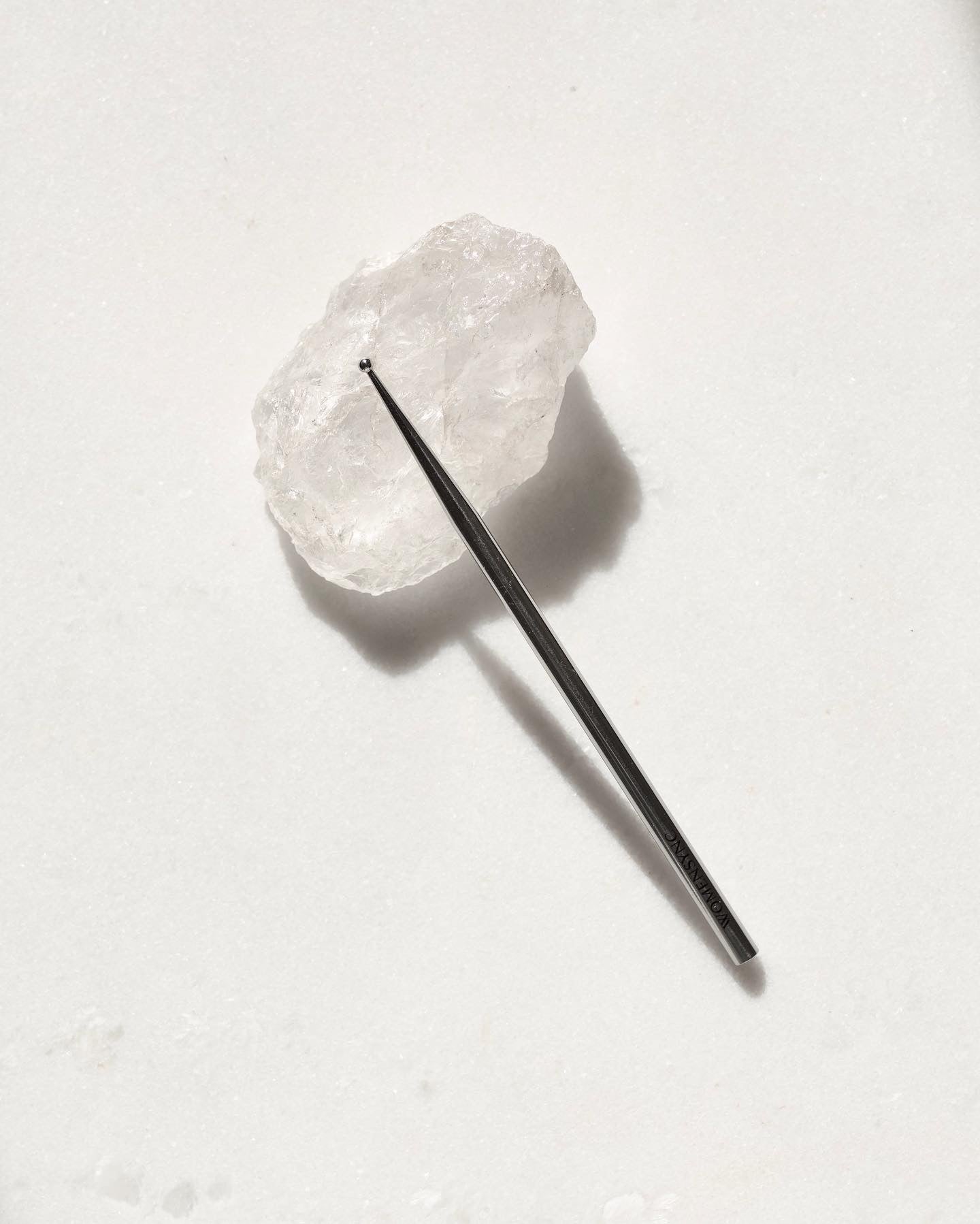Acupressure is the technique that, according to traditional Chinese medicine, is used on various points of the body and face to dissolve blockages. The purpose is to make the life force within us flow and thus achieve a state of total balance. You can easily perform this technique on yourself with the help of an acupressure pen and a face map as a guide. Let this ritual, which is said to reduce stress and care for the skin, be a relaxing addition to your selfcare routine. Let's dive deep!

What is acupressure?
Acupressure is the technique that strives to create balance in the body using pressure on various reflex points. Acupressure can also be linked with reflexology which stimulates the same points. In reflexology, however, the hands, feet and ears are primarily stimulated, while acupressure is performed on reflex points all over the body, but often on the face. However, the basic idea is the same.
Both acupressure, acupuncture and reflexology are all based on the same principle and have been around for centuries. The technology has its roots in China, but is now starting to spread like wildfire among health-conscious people around the world. You can perform acupressure on yourself for the purpose of nurturing properties for the skin, such as massage relaxation, but also to balance both body and mind.
Reflex point stimulation is used as an alternative method to reduce stress and mild pain, promote sleep and care for the skin, to name a few.
What are meridians and reflex points?
According to traditional Chinese medicine, meridians are described as channels in the body that together form a network through which Qi can flow. Qi is life energy, also called movement force, and this constantly circulates through the body to keep it in balance. If the meridians become blocked, pain or illness is said to occur. Then you need to get the flow of Qi started again by, among other things, using pressure on the body's various reflex points.
There are 12 primary meridians that run up and down the entire body via several reflex points. By performing acupressure on the reflex points, you should be able to influence the meridians and possibly dissolve blockages in the body.
Acupressure using an acupressure pen
Acupressure involves creating pressure on the reflex points with the help of a tool. It is a pen-like tool with a small rounded end called an acupressure pen . With the help of a map, you can locate the various reflex points on the face and perform the technique on yourself.
It should be a fairly hard pressure that doesn't hurt, but can possibly be described as slightly painful (always tolerable!). You can feel a tension at the pressure and then a relaxing feeling after a while. Always use an oil for better glide on the skin.
Womensync acupressure pen is made of 100% 304 stainless steel.
This is how you locate the reflex points
To stimulate the flow of Qi, life force, through the body, you can perform acupressure on various points on the face. Then you should be able to dissolve blockages and promote overall health. Here we list the various points on the face and which organs they are said to be able to affect.
- Panna: Small intestine
- Side of forehead: Bladder
- Above the eyebrows and lip: Heart
- Between the eyebrows and temples: Liver
- Under the eyes: Kidneys
- Cheekbones: Stomach
- Nasolabial folds and down towards the jaw: Colon
- Lower cheeks: Lungs
- Chin: Hormone balances
In addition to experiencing a relaxing massage and a wonderful moment when you take care of yourself, you can experience that blockages are dissolved . A nice addition to your selfcare routine.

Acupressure step by step
- Start by cleansing and applying a facial oil or a nourishing serum. This provides a good base to start on and softness for your acupressure pen to smoothly move around the skin.
- Feel how you feel and if you have any tension. Feel free to use the time to look inward and create space to relax.
- Pick up your acupressure pen and face map. Then work your way from the top of the face (forehead) downwards with the tool. Let the procedure take time and feel every point - the massage should be experienced as relaxing.
- Create a light massage like pressure with circular small movements on each point for up to 2 minutes. Feel free to repeat several rounds if necessary.
- Feel free to light a candle during this time to contribute to a maximum moment of self-care.
- Finish by massaging in a nourishing face cream or mask to hydrate the skin.
- Repeat daily or 2-3 times per week.
What are the benefits of acupressure?
There is still little research on the effects of acupressure. However, there are studies that indicate that acupressure helps to dissolve tension, reduce stress, anxiety and pain, while the technique contributes to improving well-being in general. The technique is also said to help increase blood flow, oxygenate the skin and fight both fine lines and wrinkles.
There are people who claim it has helped them boost fertility and immune systems, recover from back problems, and correct hormone imbalances, to name a few.
In a study done in 2007, The effects of foot and facial massage on sleep induction, blood pressure, pulse and respiratory rate, they compared facial massage and foot massage over a 20-minute period to decipher the effects. It was found that facial massage was experienced as more relaxing and more sleep-promoting than foot massage, while significantly lowering blood pressure.
It is important to point out that there is still little scientific evidence that this is a method that works, even though both acupressure, reflexology and acupuncture have been performed in different countries for centuries.
Regardless of whether you experience any specific effects or not, it is worth mentioning how acupressure contributes to the feeling of self-care and provides an opportunity to unwind.
Something that has been proven, however, is how massage releases our oxytocin, which is the hormone that makes us feel good, and since acupressure is considered a form of massage, you can count on a wonderful feeling afterwards.
Is acupressure safe for everyone to perform?
Anyone can perform acupressure but in some cases it should be avoided. You can always consult a doctor if you are unsure.
Avoid if:
- If you have botox or fillers
- If you are pregnant (consult your midwife)
- If you have a pacemaker or mechanical implants
- If you are demented or have Alzheimer's
- If you have open wounds
- If you use psychotropic drugs
- If you have acne or eczema that is wet/lasting
- If you have recently had surgery
In summary
Acupressure comes from traditional Chinese medicine and has been practiced for centuries. With the help of a tool, a specific technique is used where pressure is created on different points on the face and the rest of the body to create balance and well-being. The specific points are called reflex points and are said to form a network to the body's meridians, which are channels in the body that make our life force, Qi, flow. The reflex points can then affect various organs in the body and dissolve blockages. However, the scientific evidence is lacking and few studies have been done on acupressure. Whether you notice results or not, a moment of acupressure is a relaxing part of a self-care routine that can help you unwind and feel good.
If you like this post, we recommend you read:
- This is how you support the lymphatic system
This is a guest post by Amanda Jenninger. Any opinions expressed are the writer's own.
References:
Anna Ejindu ., The effects of foot and facial massage on sleep induction, blood pressure, pulse and respiratory rate 2007.03.008. Epub 2007 May 8. Available at: < www.sciencedirect.com/science/article/pii/S2005290113002082 >
National Cancer Institute, Chinese Meridian Theory. Available at: <https://www.cancer.gov/publications/dictionaries/cancer-terms/def/chinese-meridian-theory >
Eun Jin Lee , PhD, RN, ARNP and Susan Frazier , PhD, RN., The Efficacy of Acupressure for Symptom Management: A systematic Review J Pain Symptom Manage. 2011 Oct; 42(4): 589–603. Available at: < https://www.ncbi.nlm.nih.gov/pmc/articles/PMC3154967/ >
Revisiting reflexology: Concept, evidence, current practice, and practitioner training J Tradit Complement Med. 2015 Oct; 5(4): 197–206. Available at: < https://www.ncbi.nlm.nih.gov/pmc/articles/PMC4624523/ >

